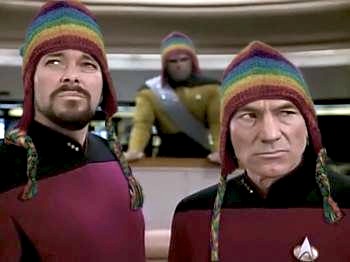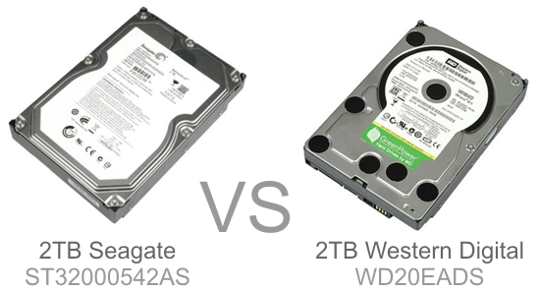I’ve received an email from one of the readers asking on how to decide between 2TB WD and Seagate hard drives – this post is in reply to this question.
Let’s start with some technical details first that we’ll translate later on to more understandable information (for those inpatient, just skip to the Conclusion section).

Power Consumption comparison 2 TB drives WD20EADS vs ST32000542AS
2 TB Western Digital WD20EADS
- Readwrite power consumption: 6W
- Idle power consumption: 3.7W
- Standby: 0.8W
2 TB Seagate ST32000542AS
- Readwrite power consumption: 6.8W
- Idle power consumption: 5.5W
- Standby: 0.5W
Seagate uses 0.8W more power while working and 1.8W more power while idle, on the other hand WD uses 0.3W more power when in Standby.
Realistic estimation of the actual power consumption is really difficult to calculate as each user uses his computer (and hard drive) in a different way – do you keep your computer working all the time, do you shut it off at night or at times away, how much do you actually use it, how much data do you transfer with it… Another variable is also an average cost of electricity in your area.
Therefore, for the purpose of this comparison, we can only work out a theoretical model – and in this case let such theoretical value be the maximum (extreme) usage of your hard drive.
Let’s assume that hard drive will be operational 24/7/365 (which is absolutely not possible, but an extreme example), that would translate to 8760 hrs per year, meaning that WD would use 8760hrs x 6W = 52560wh = 52.56 Kwh of electricity/year , and Seagate would use 8760hrs x 6.8W = 59568wh = 59.57 Kwh/year. If we assume that average price of residential electricity is $0.12Kwh, that would translate to annual consumption of $6.30 for WD vs $7.14 for Seagate – difference being only $0.84 and for theoretical 24/7/365 full-time read/write operation.
Let’s see how the same compares if the drives would be idle 24/7/365. I took the calculations on the side (won’t trouble you with numbers here), it turns out that if WD was idle the whole year it would consume $3.89 worth of electricity vs $5.78 worth of electricity translating to difference of only $1.89 – again for theoretical assumptions the drives are idle 24/7/365.
The above realistically translates in a very insignificant financial difference in electricity consumption between the two drives. I trust it is safe to say that electricity consumption shouldn’t be a purchasing factor for single/home usage in choosing between the two drives (unless you are a data center and have 1000s of hard drives in use).
2 TB Western Digital WD20EADS
- Sustained data transfer rate: 100 Mb/s
2 TB Seagate ST32000542AS
- Sustained data transfer rate: 95 Mb/s
How much are you going to miss 5 Mb/s really depends on how much you are using your computer and transferring large files. Let’s work out a theoretical model of copying a file size of a DVD disc, typically 4.7 Gb. This again is a theoretical model and would mean copying from one hard drive to another, not from an actual DVD drive as optical drives are much slower (even 10 times) than hard drives.
4.7Gb equals to 4812 Mb. That would mean that you would be able to copy DVD movie from one 2TB WD drive to another 2TB WD drive in 49 seconds vs 52 seconds from 2TB Seagate to another 2TB Seagate drive – difference being 3 seconds per movie. Realistically you won’t be able to achieve these transfer speeds as you would typically copy from your WD or Seagate drive to another, usually much slower media – and the speeds you would achieve would be of that slower media – hence both drives would most of the time achieve the same performance.
Therefore, although 2TB WD is a just a fraction faster drive than 2 TB Seagate, the actual speed difference you’d be able to notice is virtually non detectable for an average user.
Acoustics comparison 2 TB drives WD20EADS vs ST32000542AS
2 TB Western Digital WD20EADS
- Idle Mode = 25 dBA (average)
- Seek Mode 0 = 29 dBA (average)
- Seek Mode 3 = 26 dBA (average)
2 TB Seagate ST32000542AS
- Idle Mode 1.9 bels (average) = 19 dBA
- Seek typical 2.0 bels = 20 dBA
- Seek max 2.2 bels = 22 dBA
In this comparison Seagate does much better than WD in terms of acoustic performance. The difference in idle mode being 6 dB and in typical operation Seagate is 9 dB quieter than WD. The 9 dB sound compares to “calm breathing” – therefore for some sensitive ears Seagate might be a better choice.
Wikipedia’s table on sound pressure levels
- Calm breathing = 10 dB
- Calm room = 20-30 dB
- Normal taking at 1 meter (3 feet) = 40-60 dB
CONCLUSION of comparison between 2TB drives WD20EADS vs ST32000542AS
- Power consumption difference between 2TB Seagate and WD is approximated to only $1 per year in favor of WD.
- Data transfer rate difference between 2TB Seagate and WD is virtually non detectable for an average user.
- Acoustic performance difference between 2TB Seagate and WD is compared to difference in “calm breathing” – which might be considerable for noise sensitive users. The acoustic performance goes in favor of Seagate being “calm breathing” quieter drive than WD.
Therefore the performance between the latest 2 TB WD and Seagate drive is pretty close. For an average user you won’t be able to notice any difference on your electricity bill or in terms of speed. However, in a very quiet room you would be able to notice that Seagate is acoustically quieter drive. Finally, another purchasing decision between the two drives has to be the price too – which you can check clicking at the following links – current price for 2TB Western digital WD20EADS and current price for 2TB Seagate ST32000542AS.
I hope the above analysis answers the question in as simple terms as possible.
Dani



